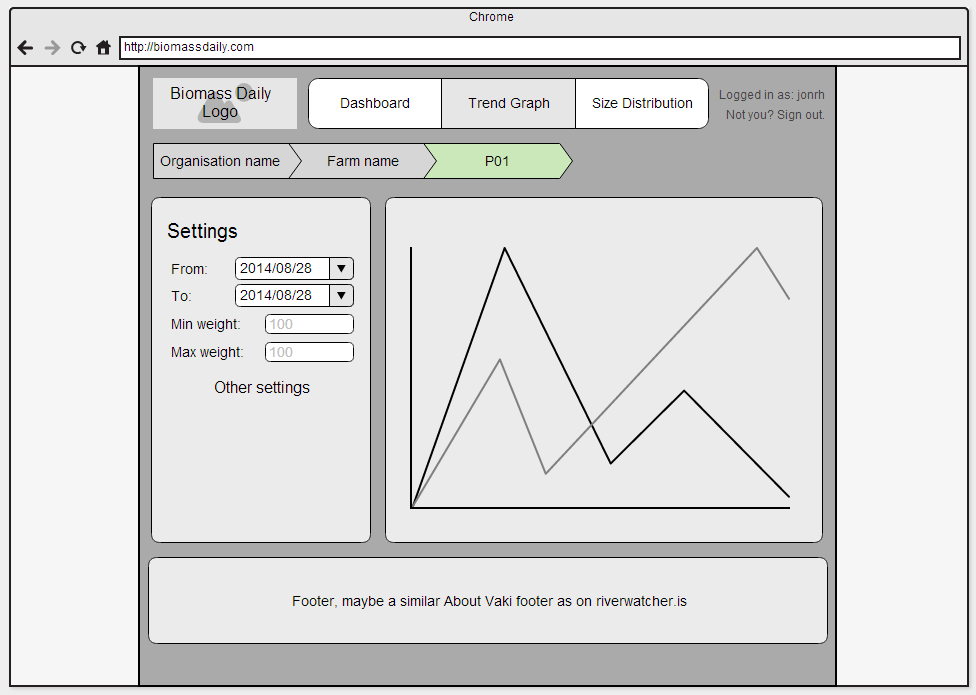Retrospective on React
March 13, 2016
This is a retrospective and a stack overview (tools used) of a software project I worked on from 2014 to 2015.
Summary:
- Jumped into the deep end of the JavaScript front-end pool
- Created an SPA using React, Reflux, and Webpack
- 13K lines of code, 70 components, 20 stores
- Experience with React largely positive
- Would pick Elm instead today
In August 2014 I started working as a software developer at Vaki (awesome workplace!), a company that specialises in making hardware and software to count and estimate the weight of live fish for the aquaculture industry. A pretty niche market but the industry is absolutely huge! The job was to design and make a new dashboard website (Biomass Daily) to replace an older system.
I worked at Vaki for one year on this project and then took a sabbatical to do an MSc in Computer Science at UCD, University College Dublin.
Architectural decision
Initial plans were to go for ASP.Net but instead we went for a web service and a single page architecture. There were two motives for this:
-
The speed of advancements in GUIs is getting faster and faster, particularly in the JavaScript ecosystem. We didn't want to lock ourself too much in with ASP.Net. Going for a web service underneath where we implement all the processing of raw data makes it easier to create and swap to a new client in the future.
-
At the time of designing we were uncertain if we wanted to create an iOS and or Android version. With a web service in place it's certainly an option at any time to add those.
Underneath we have an existing Microsoft SQL database and the company had good in-house knowledge of C# so it made sense to have the web service written in C#.
For authentication we used JSON Web Tokens (JWT). It took me some time to grok it but eventually it all clicked. We had good experience with JWT and really enjoy the simplicity of it.
More than a year later I'm very confident that these were the right decisions to make given the circumstances. When this post was written I was in a course on Swift programming for iOS. For the next few weeks I'll create an iOS app for the Biomass Daily system. Had we gone for a traditional ASP.Net website that would not have been possible.

JS framework/library selection
For the first 2 weeks I created a prototype of the site in jQuery. I had worked with jQuery before and what I like about it is how fast and intuitively you can get stuff to work. But already in week two I was starting to gravitate towards a fragile mutation spaghetti callback mess. It was now time embark on finding a suitable front-end JavaScript framework or library. Oh boy.
For context, at this time I thought I had a pretty good grip of web development. I had worked with HTML5, CSS, and programmed in JavaScript and jQuery before. I mean, how much more complicated could it be learning a new JavaScript framework/lib, right? I started realising pretty fast I didn't know as much as I thought.
There were few vague requirements that I came up with. The project was going to be a long term one, so picking an established framework was beneficial, more likely and easier to hire additional talent. The site contains lots of graphs and reports with lots of input filters, many of them shared between reports. Re-use was therefore a big factor.
I looked at a lot of frameworks/libs but the ones that stood out in my opinion were:

Ultimately we picked React with Vue in 2nd place and Mithril 3rd. The primary appeal of React was being able to more easily reuse our filters (components). Additionally we had heard very good things about React from really smart developers around us. In retrospect I think we did make the right call. Vue has though grown and improved substantially so it would probably have been a good bet as well. So now that we had decided on React it was time to learn the rest of the jungle required to make React work.
Bundler / Build Tool
For the project we used JSX to build components. JSX did take some time getting used to but overall I liked it once I got used to the quirks. ES6 was still a draft so we used CommonJS to link components together, for example:
var React = require("react");
var MenuNavigation = require("./MenuNavigation.jsx");
// do clever stuff with React and MenuNavigation
Using JSX and CommonJS required a build tool. I kinda just went with the flow what most were using in the React community and choose Webpack. It was pretty hard to get started, the cryptic documentation was not really geared towards someone that had never used a tool like this before.
The mistake I made was to start with using boilerplate configs, I had no idea what was going on in them. After some headache I decided to simply scrap the existing configs and build my own. This turned out great, it forced me to dig into Webpack's documentation to really understand how it works (or you know, just enough). The resulting config was totally tailored to the project and a mere 30 lines of code, 15 of which are comments.
After that experience I got renewed respect for Webpack. It's an incredibly powerful tool that can tackle really complicated builds, but it does require you to understand how it works.

Flux
To begin with I only used React, that is, no Flux. But pretty quickly (1-2 weeks) things were getting pretty messy. Components were passing on props that I felt they should have no concern over.
As I recall Facebook's Flux reference implementation had only been out for a few months. I tried but failed pretty miserably to grok it. I understood the concepts of actions, stores, one way data flow and that, but I just couldn't see how a Dispatcher was going to make my life any easier. Today it makes total sense to me why Facebook was so reluctant and late to release the reference implementation, it's a pattern that's tailored to them but not small to medium sized apps.
I surveyed the available Flux libraries at the time and picked Reflux. It was a very nice library and no doubt eliminated a whole lot of unnecessary boilerplate for a project of this small size. However towards the end I recall starting to have some difficulties expressing more complex data flows. I managed to express them so it wasn't a show stopper but I had started to look into alternatives to Reflux but never got around to it.

Other Libraries
We used a bunch of other libraries to varying degrees. Here are some of my favourites that I'd recommend:
-
Bootstrap 3: Ready made layout and UI components. Absolutely brilliant if you don't mind the common cookie-cutter look. We did use the react-bootstrap bindings. They were decent. The website had an okay sample of using components but there was no detailed documentation. Often times I had to jump into the source code to see what props were available and what they did. For some components I sidestepped it completely and wrote direct HTML and annotated the CSS attributes manually.
-
HighCharts: To create all sorts of graphs. Had a very good experience with it, very good documentation and intuitive API.
-
EaselJS: For when we had to do some custom graphics. We considered D3 as well but I found EaselJS's API to be more suitable for the task. A very good library with totally awesome documentation.
-
moment: Probably my most favourite JS library I've seen yet. It makes working with dates and time in JS total bliss. The documentation is absolutely brilliant.
-
i18next: For translations. We had 3 languages: English, Spanish and Norwegian. It took some time to learn to use it but after initial setup it was a total breeze to maintain translations.
-
superagent: To talk to our web service, fetching and submitting data. Pretty straight forward and simple http client.
The only library I had any issues with was react-router. I got it minimally working but it was pretty much a black box I tried to avoid. At the time it was the only router available so we were kinda stuck with it if we wanted routing but to be fair it was a long time ago, things have probably changed a lot for the better.
Summary
Three team members worked on the project for the 1 year I was involved with it. One member did all the C# webservice work. A summer intern and I constructed the React front-end app.
Here are rounded numbers for the React front-end:
- Lines of source code: 10.000
- Lines of comments and documentation: 2800
- Comment to code ratio: 28%
- Number of React components: 70
- Number of Reflux stores: 20
I'm glad that I went with React. What I liked most about it was how easy it was to add new features and refactor things. React provided hands down the best refactoring experience I've seen so far in software development. I think this is mostly thanks to the emphasis on components and unidirectional data flow.
However if I were to do everything from scratch I don't think I'd pick React again. All the nice attributes I see in React I see in another programming language: Elm.
Elm has lots of more appealing attributes I seek: static typing, immutability, no runtime errors (huge deal!), and a compiler that's actually helpful. Over the last year I've seen a huge spike of interest in Elm on Twitter. If you're curious and never heard of it I'd recommend Richard Feldman's 30 minute talk: Make the Back-End Team Jealous: Elm in Production.
If 2015 was the year of React, 2016 will be the year of Elm.
